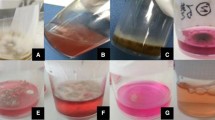Summary
It is not always possible to prevent the growth of microorganisms in organ culture for cornea preservation, despite many prophylactic measures. It is especially difficult to prove the presence of fungi in the cultural medium.
Materials and methods: A culture medium was examined for sterility after 8 days' storage of cornea in organ culture. To prove the presence of fungi a culture of Sabouraud 2 % glucose-agar was prepared and its growth examined by light microscopy.
Results: After 8 days of preservation we noticed a color change in the cultural medium and suspected contamination with fungi. Coagulase-negative Staphylococci could be cultivated from the conjunctival smear obtained before preparation of the cornea only. Routine screening of microbiological contamination did not show any results. We were able to identify an Aspergillus species only after preparing a special culture. The conjunctival smear as well as the cultural medium of the other eye of the same donor showed no contamination.
Conclusions: In spite of the fact that microbiological contamination can be seen macroscopially, it is difficult to prove the presence of a specific microorganism and even more so when dealing with fungus. Especially in these cases the incubation of the cornea in media might have an advantage because contamination can be suspected by just looking at the medium. By excluding these preparations from transplantation we can possibly prevent infections, even when routine examinations show negative results.
Zusammenfassung
Hintergrund: Das Wachstum von Mikroorganismen bei der Hornhautkonservierung in der Organkultur ist trotz verschiedener prophylaktischer Maßnahmen nicht immer vermeidbar. Der Nachweis dieser Keime kann sich schwierig gestalten.
Material und Methoden: Ein kontaminiertes Hornhautkulturmedium wurde auf Sterilität untersucht. Zum Nachweis von Pilzen wurde zusätzlich eine Kultur angelegt und die daraus hergestellten Präparate mikroskopisch untersucht.
Ergebnisse: Nach 8 Tagen Kulturzeit fiel eine Entfärbung des Mediums und eine Kontamination mit Verdacht auf Pilzwachstum auf. Die Untersuchung auf Erreger und Resistenz erbrachte einen sterilen Befund, ohne daß Pilze nachgewiesen werden konnten! Erst nach dem Anlegen einer speziellen Kultur konnte Aspergillus flavus identifiziert werden.
Schlußfolgerungen: Trotz der bereits makroskopisch sichtbaren Verunreinigung des Kulturmediums gelingt nicht immer ein Nachweis des Erregers. Die Hornhautlagerung in der Organkultur bietet hier einen erheblichen Vorteil, da das Keimwachstum an der Veränderung des Mediums erkannt werden kann und auch bei noch nicht nachgewiesenen Keimen die Übertragung von Infektionen vermieden werden kann.
Similar content being viewed by others
Author information
Authors and Affiliations
Rights and permissions
About this article
Cite this article
Jendral, G., Wilhelm, F., Bernhardt, H. et al. Difficulties in demonstrating fungi in cornea culture medium. Ophthalmologe 96, 465–467 (1999). https://doi.org/10.1007/s003470050438
Published:
Issue Date:
DOI: https://doi.org/10.1007/s003470050438




